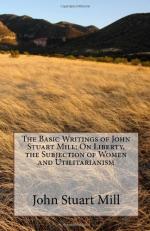
|
| Name: _________________________ | Period: ___________________ |
This test consists of 15 multiple choice questions and 5 short answer questions.
Multiple Choice Questions
1. In England, why did the number of prisoners increase?
(a) As a direct effort on the part of the whole to contrl the behavior of strong and undisciplined individuals.
(b) As more impulsive individuals began to break the laws.
(c) As a direct effort of those who know the truth against those who have strong, but faulty beliefs.
(d) As an increase in severe restrictions against liberties.
2. Who does the author assert endeavors to make everyone alike?
(a) The Norwegians.
(b) The Americans.
(c) The South Africans.
(d) The Chinese.
3. What does the author give the reader regarding this issue?
(a) A few examples.
(b) A few responses.
(c) A few opinions.
(d) A few questions.
4. How does the author see the lessening of separation and the variety of situations?
(a) As a gain.
(b) As a loss.
(c) As a nuisance.
(d) As a weakness.
5. How does the author begin this chapter?
(a) With a statement.
(b) With a demand.
(c) With a question.
(d) With a request.
6. What else does the author address at the beginning of this chapter?
(a) To what extent the government or the attendant culture and community have a just claim to control the individual.
(b) What will be the cause of sovereignty.
(c) Who will control the government or the attendant culture and community.
(d) Who will feel the need for sovereignty.
7. What is the definition of this type of trade?
(a) Only trade unions may participate in this form of trade.
(b) The state will not regulate the manufacturing and marketing of products but that competition in the marketplace without monopoly.
(c) This isolates a country by not allowing it to trade with others.
(d) This is trade between many countries.
8. What religious sect had the author previously cited?
(a) The Jehovah's Witnesses.
(b) The Unitarians.
(c) The Presbyterians.
(d) The Lutherans.
9. What did Humboldt believe is the greatest goal in the holistic development of humanity?
(a) To be religious and faithful.
(b) To be kind and loving.
(c) To be complete and whole.
(d) To be happy and healthy.
10. What happens to the other goods and services?
(a) They grown stronger.
(b) They permanently fail.
(c) They recede into the background.
(d) They stay the same.
11. Does the author believe that the notion of 'the Sabbath' requires a religious justification?
(a) Yes.
(b) Usually.
(c) No.
(d) Often.
12. What is part of the reason for this discussion?
(a) So that readers of the future can make political decisions that are directly relevant to them.
(b) So that readers of the author's time period and culture can make political decisions that are directly relevant to them.
(c) So that readers of today can make political decisions that are directly relevant to them.
(d) So that readers of other cultures can make political decisions that are directly relevant to them.
13. What does the author imply that exist to make the best of the citizenry?
(a) Various social policies.
(b) Programs.
(c) Schools.
(d) Organizations.
14. How does the author take the matter discussed in previous chapters into a deeper discussion?
(a) He delves deeper into the compromising of people in a society.
(b) He delves deeper into the individuality of people within a society.
(c) He delves deeper into the obstacles facing democracies.
(d) He delves deeper into the effects of tyranny.
15. To what does this analysis lead?
(a) Mill and Taylor showing how intereference is always needed.
(b) Mill and Taylor showing how interference is never needed.
(c) Mill and Taylor showing how there are times when the interference and control of the individual by the state is entirely legitimate.
(d) Mill and Tayolor showing how control of an individual takes away his or her right to liberty.
Short Answer Questions
1. Where does this example take place?
2. To what does the author refer regarding variety of situation?
3. When should drugs be used?
4. What matter does the philosopher then take up?
5. Do Mormons face persecution in Mill's society?
|
This section contains 692 words (approx. 3 pages at 300 words per page) |

|




